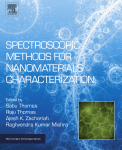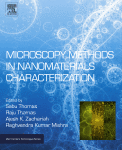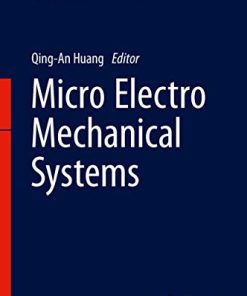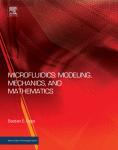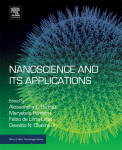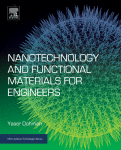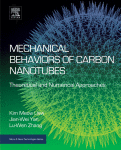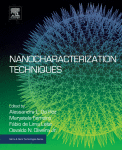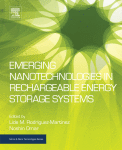Microbiorobotics. Biologically Inspired Microscale Robotic Systems A volume in Micro and Nano Technologies 1st edition by Minjun Kim, Agung Julius, U Kei Cheang 0323430197 9780323430197
$50.00 Original price was: $50.00.$25.00Current price is: $25.00.
Microbiorobotics. Biologically Inspired Microscale Robotic Systems. A volume in Micro and Nano Technologies 1st edition by Minjun Kim, Agung Julius,U Kei Cheang – Ebook PDF Instant Download/DeliveryISBN: 0323430197, 9780323430197
Full download Microbiorobotics. Biologically Inspired Microscale Robotic Systems. A volume in Micro and Nano Technologies 1st edition after payment.
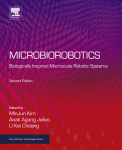
Product details:
ISBN-10 : 0323430197
ISBN-13 : 9780323430197
Author: Minjun Kim, Agung Julius,U Kei Cheang
Microbiorobotics: Biologically Inspired Microscale Robotic Systems, Second Edition presents information on a new engineering discipline that takes a multidisciplinary approach to accomplish precise manipulation of microscale spaces.
Microorganisms have evolved various mechanisms to thrive in microscale environments and are therefore a useful tool for use in many applications, ranging from micromanufacturing techniques, to cellular manipulation. In the context of microrobotics, biological microrobots can directly harness the microorganisms for propulsive and sensing power and synthetic microrobots can mimic the microorganisms’ motions for effective locomotion.
This second edition covers new advances and insights that have emerged in recent years. Several new chapters have been added on important new research areas, with existing chapters thoroughly revised. In particular, increased coverage is given to fluid dynamics of microswimmers in nature.
Microbiorobotics. Biologically Inspired Microscale Robotic Systems. A volume in Micro and Nano Technologies 1st Table of contents:
Part 1: Introduction
Motivation for microbiorobotics
References
Historical overview
Low Reynolds number swimming
Taxis of microorganisms
Artificial bio-inspired microrobots
Biological microrobots
Conclusion
References
About this book
Theoretical microbiorobotics
Biological microrobots
Synthetic microrobots
Part 2: Theoretical Microbiorobotics
Chapter 1: Controlling swarms of robots with global inputs: Breaking symmetry
Abstract
1.1. Introduction
1.2. Breaking symmetry
1.3. Breaking symmetry with robot inhomogeneity
1.4. Breaking symmetry with obstacles
1.5. Conclusion
References
Chapter 2: Optimization of magnetic forces for drug delivery in the inner ear
Abstract
2.1. Introduction
2.2. Ear anatomy
2.3. Diffusion model of magnetic particles
2.4. Simulations and results
2.5. Discussion
2.6. Conclusion
References
Part 3: Biological Microrobots
Chapter 3: Development of active controllable tumor targeting bacteriobot
Abstract
3.1. Fabrication and surface modification of biocompatible microbeads
3.2. Evaluation and control of bacteriobot motility
3.3. Motility evaluation of the bacteriobot
3.4. In vivo test of the tumor-targeting properties of bacteriobots
3.5. Conclusion
References
Chapter 4: Control of magnetotactic bacteria
Abstract
Acknowledgments
4.1. Introduction
4.2. Characterization of magnetotactic bacteria
4.3. Control of magnetotactic bacteria
4.4. Concluding remarks
References
Chapter 5: Obstacle avoidance for bacteria-powered microrobots
Abstract
5.1. Introduction
5.2. Kinematic model of a bacteria-powered microrobot
5.3. Obstacle avoidance approach
5.4. Motion under obstacle avoidance
5.5. Conclusions
References
Chapter 6: Interacting with boundaries
Abstract
References
Part 4: Synthetic Microrobots
Chapter 7: Control of three bead achiral robotic microswimmers
Abstract
Acknowledgments
7.1. Introduction
7.2. Fabrication, properties, and propulsion of microswimmers
7.3. Magnetic control system
7.4. Modeling and considerations for control
7.5. Motion control
7.6. Conclusion
Funding
References
Chapter 8: Micro- and nanorobots in Newtonian and biological viscoelastic fluids
Abstract
8.1. Introduction
8.2. Self-propelled soft microswimmers and microrobots
8.3. Helical propellers in non-Newtonian biological media
8.4. Swimming by reciprocal motion in non-Newtonian fluids
8.5. Conclusions
References
Chapter 9: Magnetic microrobots for microbiology
Abstract
Acknowledgments
9.1. Introduction
9.2. Single microrobot methods
9.3. Modeling and control for single magnetic microrobots
9.4. Vision-based tracking
9.5. Multirobot manipulation
9.6. Problem formulation
9.7. Simulation
9.8. Multirobot experimental results
9.9. Conclusion
References
Chapter 10: Magnetic mobile microrobots for mechanobiology and automated biomanipulation
Abstract
10.1. Introduction
10.2. State-of-the-art: micro-force sensing, mobile magnetic microrobot
10.3. Micro-force sensing mobile microrobot
10.4. Concluding remarks
References
Chapter 11: Magnetic swarm control of microorganisms
Abstract
Acknowledgments
11.1. Introduction
11.2. Materials and methods
11.3. Results and discussion
11.4. Conclusion
People also search for Microbiorobotics. Biologically Inspired Microscale Robotic Systems. A volume in Micro and Nano Technologies 1st:
are men biologically stronger
how many genders are there biologically
are lobsters biologically immortal
is a surrogate baby biologically yours
is homosexuality biologically based brainly
Tags: Microbiorobotics.Biologically, Robotic Systems, Nano Technologies, Minjun Kim, Agung Julius, U Kei Cheang
You may also like…
Engineering
Science (General)
Engineering
Nanoscience and its Applications A volume in Micro and Nano Technologies Osvaldo Novais De Oliveira




